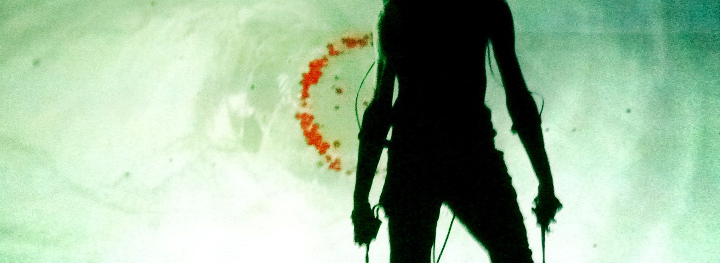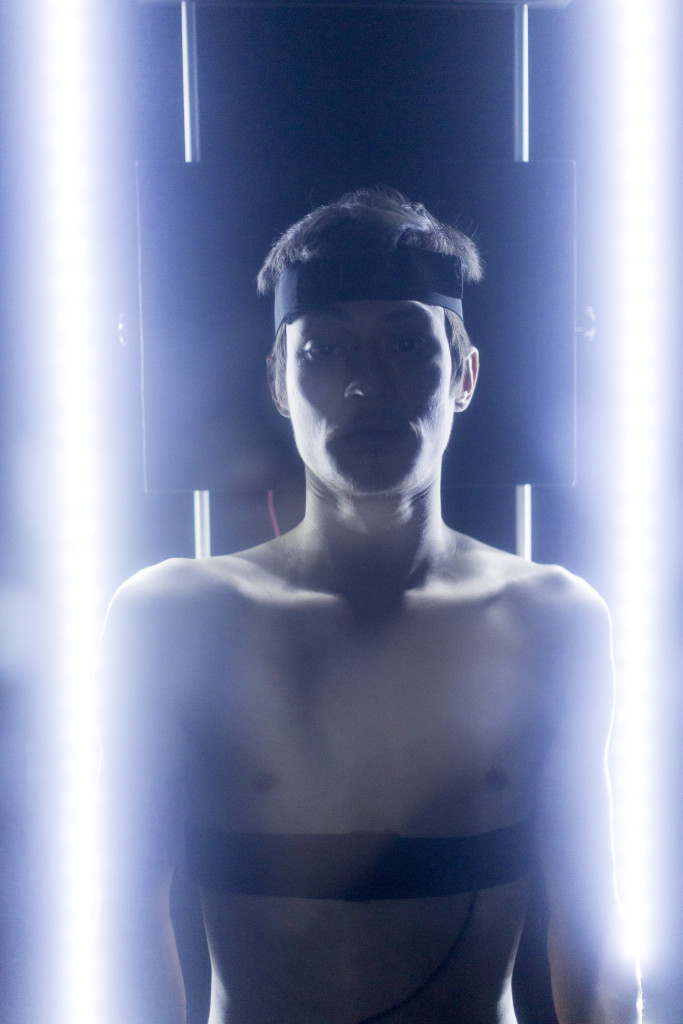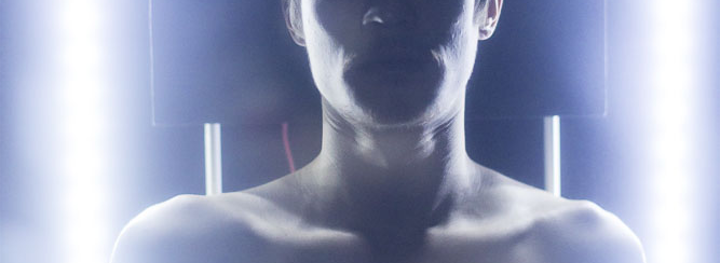curated by Arianna Forte
«The invisibility of the eye within its own visual field, the diaphanous embodiment of language, the inaccessibility of the visceral organs: these all exhibit their own principles of absence, which can only be teased apart by a careful investigation.»
(Drew Leder, The Absent Body, 1990)
Humans shape every single experience through the body yet the body itself tends to disappears since it normally works. To understand the paradoxical nature of our existence, the American philosopher Drew Leder bases his own theory on this statement: while in one sense the body is the most abiding and inescapable presence in our lives, it is also characterized by its absence.[1] The body within escapes from both control and perception.
Human beings find in themselves an unknown part of their body that acts independently from their will. This is the strength from which the existence of their body depends. A strength that wriggles into the veins twists and turns, hidden behind dark organic tissues and membranes and called by Leder with the term foreign-meness[2]. So, the inner being has an ambiguous and contradictory connotation: it is obscure and unreachable and at the same time it is essential and vital.
This body absence, that constitutes the organic itself, has a new relevance in Marco Donnarumma artistic practice. Here, his works come directly from his organic functions: from the pulsing blood flow to vibrating muscle tissues. Thanks to specific technological processes that he has named biofisical media, he succeeds in figure out inner body sounds and whispers generally incomprehensible and translates them in musical performances or installations.
The digital artist Donnarumma is also a PhD researcher at the Goldsmiths University Of London and his work is the outcome of a theoretical and practical whole knowledge and awareness. His research is based on a new technology that the artist himself has created through the elaboration of the biofeedback principles: the Xth Sense, which is a biophysical system specifically made for interactive musical performances[3]. The hardware is made up of wearable biosensors-microphones that capture inner sounds, without any contact with the skin.
In order to elaborate and process income data during his performances, he uses an open source software on Pure Data: a programming language that allows him to develop the audio-video signal in real time[4].
Last January, during the event CTM-Festival for the Adventurous Music and Art in Berlin, he performed Ominous employing the above-mentioned biophysical system: Marco Donnarumma was the creator, the performer and the vehicle itself of his own musical composition.
In a half-lighted room, the artist made his debut with sloppy and convulsive gestures that turned soon in a choreography of fluctuating arms in an empty space. Two sensors placed on his forearms were catching the slight vibration of his muscle contractions[5].
The sound of his flesh was synthesized, live sampled and reproduced by loudspeakers. At first metal creaks emerged and gradually became more intense in an hypnotic and essential resonance: at that point organic vibrations turned into clear and audible sound waves. In this way the public senses were totally saturated.
As a concertmaster who does not need instrumentalists, Donnarumma perfectly conducts the harmony of his body tissues.
Leder’s absent body becomes a source of music. The artist releases the interoceptive flow that has always been silent and mysterious and in this way it becomes a concrete experience, sonic material and primordial expressiveness.
Donnarumma introduces a new way of creating electronic music based on muscular sounds provided by gestures.
The sound capacity of human tissues in Ominous, and also other works, is made possible only through the Xth sense. In fact, this new innovative and peculiar technology has been considered as «the world’s most innovative new musical instrument».[6]
Donnarumma fits totally and consciously in that branch of scholars who, for more than half century, investigate on the human-machine interaction and specifically on the role of technology which «since the 80s has started to penetrate under our skin».[7] In this panorama many intellectuals, such as the so called Apocalittici e Integrati[8], argue on new technologies subject: some of them calls for a Rousseau’s nature state or others declare themselves as enthusiastic transhumanists. The latter, referring to the Cyborg utopia where man and machine are combined in a new entity[9], foresees that soon the organic body will be replaced by an artificial one. The most representative artist is Stelarc, who supports the idea of «the biological inadequacy of the body instead of the perfection of technology»[10] and in the light of this belief, he promoted his body modification with the machine.
Stelarc may be considered a Donnarumma’s precursor, in fact, already during the 70s with the Amplified Body performances, he has seen the organism as a sound source employing bioacoustic signals[11].
However, the young Italian researcher overtakes the Stelarc hyperbolic approach perceiving technologies as reflective: he does not consider technology as an instrument to strengthen or replace the body, but as a concrete way to understand and revalue the human being.
Donnarumma belongs to the generation of artists and intellectuals that refuses the traditional opposition between humans and machines. Moreover, he creates a relationship with technologies and establishes a dialogue [12] with them. In fact, his study focuses on the reciprocity of this relationship, it means that «the body extends itself through the machine but also the machine extends itself through the body».[13]
The idea of reflexivity of technology and reciprocity between human and machine are clearly shown in his last artwork: Nigredo. This installation provides a strong physiological and sensory introspection.
In this case, the Xth sense abilities are not used to create a musical composition as in Ominous, but are at the service of whoever would like to feel a new side of its own physicality, which is impossible to feel without the machine.
Nigredo is an eight minutes experience where a single person sits in front of a mirror monitored by sensors that catch the heartbeat sound, blood flow and muscular contractions. The resulting sound is digitally processed and led back to the body in the form of new stimulus: a juxtaposition of sound, lights and vibrations in different intensities and combinations.
At first, the visitor is brought to a perceptual deprivation and then he is stimulated in many ways, in order to provoke physiological, physical and neural alterations.
The union of strong vibrations, sounds and epileptic lights interferes with neurophysiological processes that control nervous system. The human body is not able to identify the difference between the internal and external stimuli, so the perception of his own image changes on the mirror together with the perception of his body.[14] It is a deep and disturbing experience for our body that is re-sentitisized. The absent body is shaken by this continuous sensory turmoil. Through the Xth Sense, the rhythm of the internal movements is increased and digitally amplified in order to bring the foreign-meness out. In other words, the internal automatisms, normally inaccessible to a direct and aware control, become finally conscious. The visitor finds out a new, extraneous and obscure part of his on which depends his life but maintaining always a strict silence.
«The inner body becomes the source of an altered narrative of self-perception»[15]. The vibrations of the body’s internal organs, until that moment always silent and absent, reverberate in its flesh. Through the mirror, the visitor can see the union of his internal and external body.
The entire Donnarumma’s artwork is aimed to spread out the viscerally, the silent power that lies in the physiological carnality, in the instincts voracity and in the deep inscrutability of our body.
And what in our collective imagination is the symbol par excellence of artificiality, technology, can reveal our deepest corporal identity. It is the inorganic, in this eventuality, that will allow us to rejoin ourselves with the organic.
«Today technology is both widespread and invasive […] on one hand spreads around body, modifying it and extending it, on the other insinuate itself in the organism […] and there it forces us to confess that our body, his sensorymotorial mechanisms is ancestral theca, the intelligence earliest container».[Giuseppe O. Longo, Homo tecnologiucus, 2005]
[1] Drew Leder, The Absent Body, Chicago-London , The university of Chicago press, 1990, pp.10-11;
[2] Leder, ivi, p.48;
[3] Marco Donnarumma, Xth sense: recoding visceral embodiment, In Proceedings of the CHI workshop on Liveness, 2012;
[4] Ibidem;
[5] Marco Donnarumma, Music for Flesh II: informing interactive music performance with the viscerality of the body system. Proceedings of the 2012 Conference on New Interfaces for Musical Expression (NIME-12), Ann Arbor, Michigan, 2012;
[6] In 2012 Marco Donnarumma won the first prize at Margaret Guthman New Musical Instrument Competition of Georgia Tech, one of the most important technological research centre in United States . In occasion of the award Xth Sense (XS) has been nominated “world’s most innovative new musical instrument;
[7] Bruce Sterling in Antonio Caronia, Il cyborg. Saggio sull’uomo artificiale , Milano , Shake, 2001, p.12;
[8] Quote from the title of the well-known Umberto Eco’s essay;
[9] Caronia, ivi;
[10] Stelarc, Da strategie psicologiche a cyberstrategie: prostetica, robotica ed esistenza remota in Pier Luigi Capucci, Il corpo tecnologico. L’influenza delle tecnologie sul corpo e sulle sue facoltà, Baskerville, Bologna, 1994, p. 64;
[11] ibidem;
[12] «It has undergone a meta(l)morphosis and is now positioned in the spaces in between the traditional dichotomies, including the body-machine binary opposition. In other words, it has become historically, scientifically and culturally impossible to distinguish bodies from their technologically- mediated extensions.», Rosi Braidotti, Metamorphoses: Towards a Materialist Theory of Becoming, Cambridge, Polity Press, 2002, p. 228;
[13] See the following interview;
[14] www.marcodonnarumma.com;
[15] ibidem.
Marco performing Ominous at Spectrum, New York City (US). Picture courtesy of Ugo Dalla Porta

We met Donnarumma at the opening of CTM festival in Berlin.
In wich direction is your research proceeding?
Since several years, I’m conducting an artistic research that focuses on the human-machine interaction and specifically I deal with biotechnologies and performance arts. I’m attending a Ph.D in Arts and Computational Technology at the Goldsmiths, University of London. This university has been the first academic center that promoted the collaboration between artists and computer scientists. We are a research team centred on music and we work on metagesture music project supported by European Research Council. The project explores the notion of gesture as a physical, musical and physiological gesture. Our supervisor is Atau Tanaka. [Japanese musician and artist, pioneer of the biosignals employ for the musical composition and still one of the most famous representative of the biomusic field.]
So does your research develop in several directions, not only on biosensors?
Yes, but it’s always on biotechnologies. My doctoral thesis focuses on going beyond the notion of control in the human-machine interaction. I’m proceeding on the assumption that human body and machine are both composed of matter and this matter can be hang up in several way for specific aims. This kind of interaction goes beyond the simple coupling, because the body extends itself through the machine but also the machine extends itself through the body. A concrete example is the possibility to do mathematical operations through DNA code that has been used for several years: DNA is used to conduct very difficult algorithms with services out of the range of electronic computer. So, in this way, the machine extends itself through the body. I called this process configuration, it’s a concept that I deduced from process philosophers as Gilbert Simondon, Bernard Stiegler e Gilles Deleuze.
How is your theoretical research connected with your artistic practice?
My theoretical research leads to artistic practise and to the developing of technical instruments. For istance, Nigredo [created on 2013 together with the artist and engineer Marije Baalman] was a doctoral work, it’s based on this idea of configuration and it’s ispired by the nature that human and machine shares, the matter. I have tried to find a performative way to explore this phylosophical concepts and from there I have developed the installation and then the technical instruments to actualize it.
How does the machine complete itself with the human body in Nigredo?
The ability of the human body is to listen to itself and to access to a certain level of self perception that is impossible to reach in daily life. The machine, for its part, extends itself through the human body recording the visitor’s organic sounds, his heartbeat, his blood flow, his breathing. It captures these elements making them as the primary source of the machine. If none had been sit there, the machine would not work. The machine processes these sounds and it sends them back to the visitor’s body using transducer directly connected to his bones. So, without the visitor’s body nothing would happen, the transducers would not emit any sound: they need a human body from which they can capture stimuli. The istallation would not work with a dead body inside, as other installations that turn on and work in the same way simply with a dog in front of it… A dog would not be able to integrate Nigredo, since it is composed of a chair and vibrations are sent on the seatback to the spine. Everything is set up in a specific way in order to reach a specific objective. What that I want to reach is not a definitive level but a process. It is the pratical application of the configuration that I mentioned before.
And what about Ominous? How does this human-machine relation come out?
In Ominous this phylosophical reflection is neither clear nor aware, since it is one of my first work using Xth Sense.
It seems that the Ominous conceptual focus is the fact that the body is seen as a musical instrument…
Yes, it is. At first I have planned work as Ominous that led me to the Ph.D. I have created
Xth Sense to develop this research on the body as an expressive and musical physiological source.
Let’s come back. How have you approached with Xth Sense?
I invented Xth Sense to use the body as a musical instrument. In fact, my first performance with this technology, Music for flesh II, was kind of a concert… but soon I realized that Xth Sense has much more potentialities that I could explore. After performing Music for flesh II at least seventy times, I decided to create something that could go in a different direction: Hypo Chrysos. I was interested in musicianship notion and I was inspired by John Cage, obviously by Stelarc and Yann Marussich.
Hypo Chrysos is an audiovisual performance based on Xth Sense. Is it the only artwork in which you use a video?
To be honest I have done videos for five years and then I got specialized on sound. I am interested also in video as an expressive vehicle but I want to use different media only if necessary. I hate when lot of media are used superfluously but it is a very common habit. So, I use the sound as a medium, sometimes video and starting from Nigredo I am using also the light, that was the video real essence…
Are you working on any artwork now?
Well, Nigredo is extremely complex and I will keep on working on it until I will totally examine it. For istance, I created Music for flesh II in 2011 and now I have perfomed it at CTM: I have changed two or three things in four years, but I want to keep this version, even if now I do not like it very much… But if I change it, it becomes another work!
And Nigredo is a very difficult work to show. Firstly because it is technically complex and then because is a very risky choise for the curator, not everyone wants to take it since it is a very deep psychological and physical experience for the visitor. Usually when the performance is finished, people stay silent for two minutes but everybody has thanked me so far, because it is a not daily experience. The classical question is: «Is my body really able to do that?»
So, when will be possible to visit Nigredo in the near future?
I have presented Nigredo only twice [and he got the first prize in both festivals N.d.R.], at The New Media Art and Video Festival TRANSITIO_MX in Mexico and at Cynetart in Germany. I am not interested in perform my work around, but only in those places where I am sure that experimentation is appreciated. Next time Nigredo will be presented at Musikprotokoll, a festival organized by the Austrian national radio.
http://musikprotokoll.orf.at/









